How much should you budget for a good eMTB? After lining up 25 of the best eMTBs in our big 2020 high-end eMTB group test, we’ve picked out eight of the most exciting bikes under € 5,500 to compare. What should you look out for when buying an eMTB on a budget? Where will you have to compromise? And, finally, which is the best eMTB under € 5,500?
Table of contents What is in this test?
- What should the best eMTB be capable of?
- How do we determine the price-performance ratio of a bike?
- The test field
- Why doesn’t the test field include a Canyon or Specialized Levo?
- Is the head angle too steep?
- Motor and battery – an optimal balance of integration, performance and range
- Even small details make big a difference
- Which is the best eMTB under € 5,500?

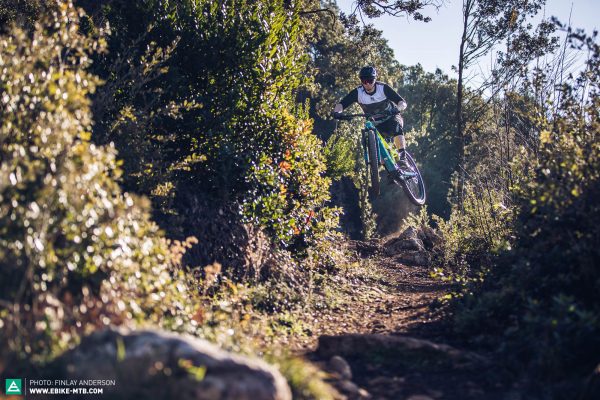

What should the best eMTB be capable of?
eMTBs are better than ever and have never been as fun as they are in 2020. As our reader survey with over 11,000 participants revealed, eMTBers use their bikes for an increasingly wider range of applications. Hence, it seems logical to ask ourselves: what should the best eMTB under € 5,500 be capable of? In this test we were looking for the best all-rounder, an eMTB that is suitable both for trail riding and exciting tours. The best eMTB should be able to blend supposed opposites and, ideally, offer a high degree of comfort while providing predictable and direct handling. And of course, security and safety are very important too. That’s why a solid spec with powerful, easy-to-modulate brakes and grippy tires is just as important as plush and efficient suspension. We will also tell you which brands offer interesting optional features such as a lighting system, making their bikes particularly suitable for everyday use. Nevertheless, such details don’t significantly affect the overall rating of the bikes – after all, riding fun is our number one priority!
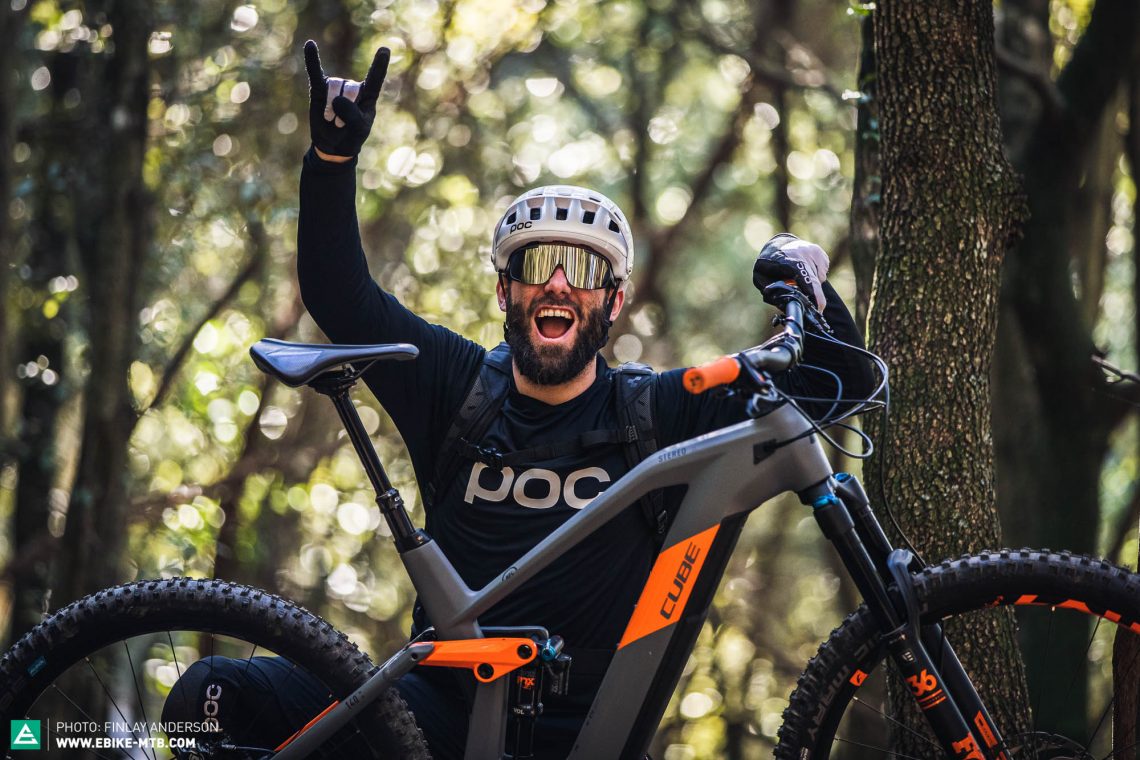
How do we determine the price-performance ratio of a bike?
Let’s be clear. With an average price of € 5,224 the bikes in this test aren’t exactly a bargain. On the other hand, all prices are within your budget. According to our survey, you’re planning to spend an average of €5,055 on your next eMTB. However, there’s a difference in price of € 500 between the most expensive and cheapest bike in test. While in context, this might not sound like a lot of money, it could easily be a deal breaker for some of you – especially considering some of you are still going to need some spare change to sort out your riding gear. So, it goes without saying that the price-performance ratio of a bike plays a crucial role in this test. Here at E-MOUNTAINBIKE we focus explicitly on trail performance and not on the bling factor of single components. A good price-performance ratio is generally achieved with a thoughtful balance of the performance of the overall package, the trail- and tour-suitability of the bike as well as the suitability of the spec for the intended use and purpose of the eMTB. What’s the point in having the best motor or the most expensive wheelset if the geometry or suspension are no good?
In this group test, we have made it our mission to identify and evaluate all the price-related compromises that the brands have made. Perhaps the best example of this is the choice of displays on bikes with a Bosch motor. Both the Kiox and Purion displays work very well on the trail and offer all essential functions, but the Kiox is much more expensive. Even then, the KIOX display isn’t perfect… but that’s a totally different story. The bottom line is that manufacturers can make (and have made) sensible savings in this area, allowing them to invest in components that matter more for riding performance.
Manufacturers should never skimp on safety! In particular, when it comes to the brakes, we expect a modern eMTB to feature powerful four-piston brakes with at least 200 mm rotors, both front and rear. In this respect, we have to pick a bone with two of the manufacturers, who deliver their bikes with brakes that are simply not strong enough for their intended purpose.
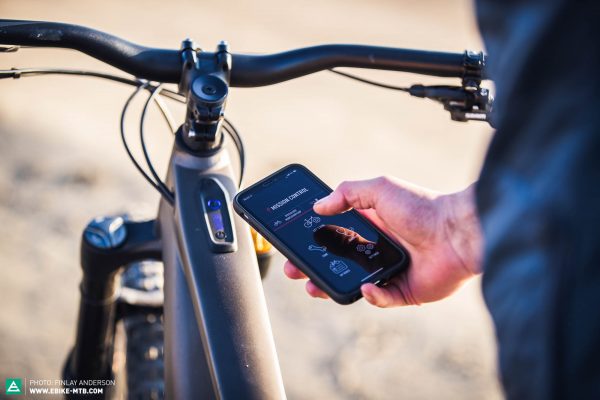
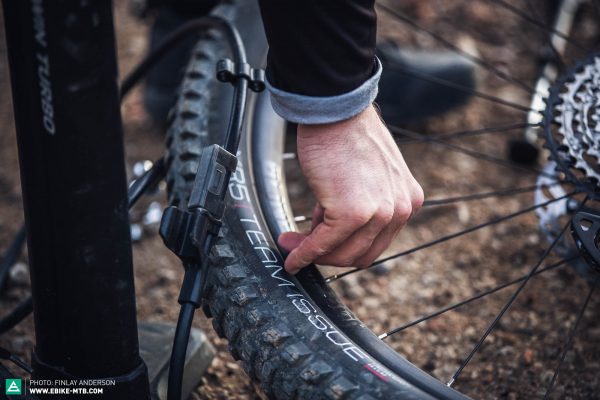
The test field
At first, the choice of interesting eMTBs under € 5,500 might seem huge. But having excluded hardtails, outdated frame platforms and downhill bikes with XC tires, we were left with about ten candidates suitable for both trails and extended tours.
In our opinion, there’s no point in categorising eMTBs based on suspension travel or appearance. This explains why our test field also includes the Specialized Kenevo, which enters the race with a whopping 180 mm of travel. The previous version, which had the same amount of travel and impressed our test crew with its outstanding all-rounder credentials, managed to secure our Best in Test badge in last year’s eMTB group test. With 150 and 140 mm travel front and rear, the CUBE Stereo Hybrid 140 HPC and RADON RENDER 10.0 are the two bikes with the least amount of travel. That being said, the quality of the suspension is much more important than the actual amount of travel. For example, the SCOTT Genius eRideIDE 920 features the complex TwinLoc system which allows you to adapt the ride at the push of a button. However, it offers limited functionality compared to the full-fledged version on the more expensive model. Moustache, on the other hand, deliver their Samedi 29 Game 4 with the same in-house shock as their top of the range model, which costs € 2,500 more. With this clever move, the French brand ensures the same superb rear suspension performance across the entire range.
When it comes to frame material, we make no distinctions: a high-quality alloy frame, like that of the Trek Rail 7 is just as good as the carbon frame of bikes like the CUBE and RADON. For the record, a carbon frame won’t give you tangible benefits in either trail performance or weight. With an average weight of 24.03 kg, the few grams you save with a carbon frame won’t make a difference. If you ask us, an alloy bike with top suspension and superb trail performance is always a better choice than bikes with a carbon frame and a mediocre spec. Even the endless wheel size debate didn’t play a major role when it came to choosing the bikes for this test. While there is a clear trend towards large 29 ”wheels (five out of eight bikes come with big wheels), only two brands, Centurion and Specialized, opted for smaller 27.5” wheels. Finally, with the XDURO AllMtn 3.0, Haibike is the only manufacturer that uses a mullet setup, with a large 29 ”wheel up front and an extra wide 27.5 x 2.8” rear tire.
| Bike | Motor/Battery | Price | Weight | Travel | Wheel size |
|---|---|---|---|---|---|
| CENTURION No Pogo E R2600i (Click for review) | Bosch Performance Line CX 75 Nm/625 Wh |
€ 5,099 | 23.82 kg | 160/155 mm | 27.5″ |
| CUBE Stereo Hybrid 140 HPC (Click for review) | Bosch Performance Line CX 75 Nm/625 Wh |
€ 4,999 | 24.75 kg | 150/140 mm | 29″ |
| Haibike XDURO AllMtn 3.0 (Click for review) | Bosch Performance Line CX 75 Nm/625 Wh |
€ 4,999 | 25.60 kg | 160/160 mm | 29/27.5″ |
| Moustache Samedi 29 Game 4 (Click for review) | Bosch Performance Line CX 75 Nm/625 Wh |
€ 4,999 | 24.35 kg | 160/160 mm | 29″ |
| RADON RENDER 10.0 (Click for review) | Bosch Performance Line CX 75 Nm/625 Wh |
€ 5,499 | 24.35 kg | 150/140 mm | 29″ |
| Scott Genius eRIDE 920 (Click for review) | Bosch Performance Line CX 75 Nm/625 Wh |
€ 5,199 | 22.90 kg | 150/150 mm | 29″ |
| Specialized Kenevo Comp (Click for review) | Specialized 2.1 90 Nm/500 Wh |
€ 5,499 | 23.08 kg | 180/180 mm | 27.5″ |
| Trek Rail 7 EU (Click for review) | Bosch Performance Line CX 75 Nm/625 Wh |
€ 5,499 | 23.40 kg | 160/150 mm | 29″ |
| Ø € 5,224 | Ø 24.03 kg |

23.82 kg (size L) | € 5,099
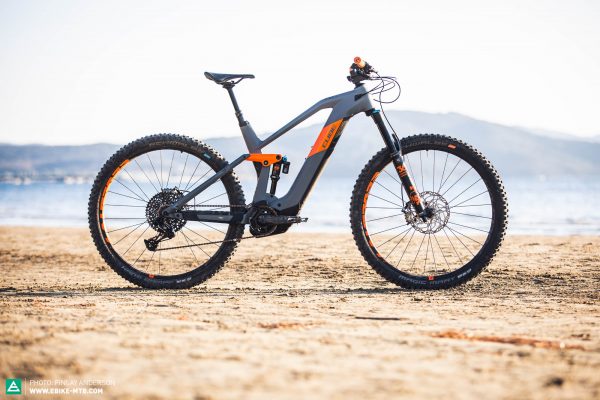
24.75 kg (size L) | € 4,999
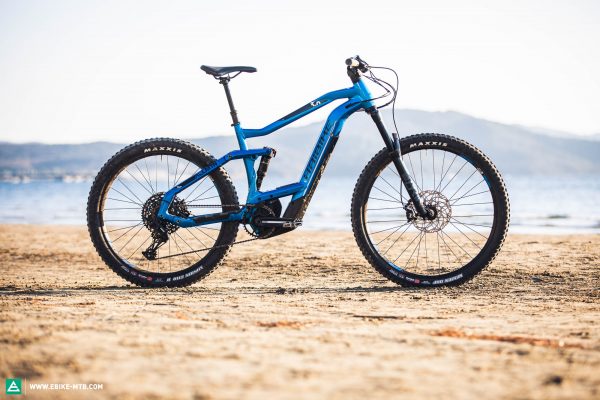
25.6 kg (size L) | € 4,999
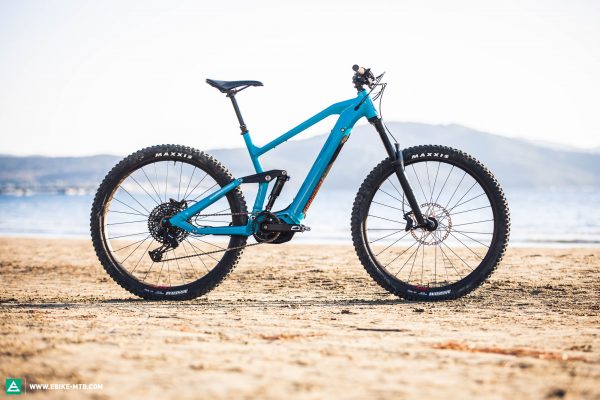
24.35 kg (size L) | € 4,999

24.35 kg (size XL) | € 5,499

22.9 kg (size L) | € 5,199
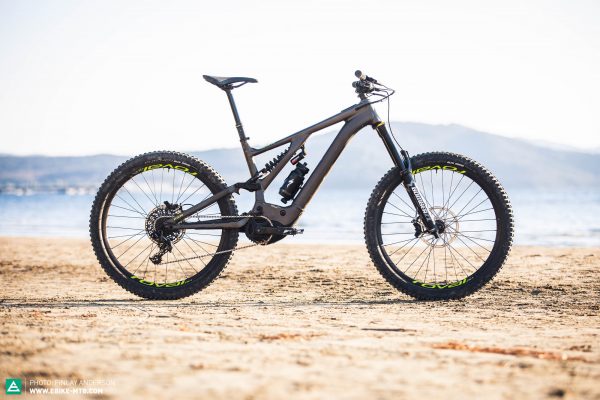
23.08 kg (size S4) | € 5,499

23.4 kg (size L) | € 5,499
Why doesn’t the test field include a Canyon or Specialized Levo?
Compared to our high-end eMTB group test, which includes a whopping 25 bikes, the number of candidates here is rather small. This time around we opted for a smaller test field and trimmed down the initial number of participants by running a tough preselection round with a number of strict criteria. As an example: since we’ve already tested the Canyon Spectral:ON in pretty much all of its spec variants and you probably already know everything about its handling, spec and details, we decided not to include it in this test. Furthermore, our latest group test revealed that the Spectral:ON can no longer keep up with the latest developments in the eMTB segment. Perhaps the toughest decision we had to make was whether to pick the Specialized Kenevo – which secured the our Best in Test badge in last year’s group test – or the Levo, which can rightfully call itself “the best eMTB of 2020” in its top-spec version. At € 6,199, the Levo Comp clearly exceeds our € 5,500 price limit, while the cheapest Levo which retails at € 4,799, lies well below it. Specialized also make some significant compromises on the entry-level Levo, trying to save money by using a very basic (and weak) two-pot brake. At € 5,499, the Kenevo perfectly matches the budget for the test field and offers a very exciting, competitive overall package, meaning it holds all the cards to defend its title. Commencal, YT Industries and Propain all agreed to take part in this group test but were unable to send a bike in time for our test.
Is the head angle too steep?
Bike nerds and tech geeks beware! Apart from the motor, hardly any other topic in the eMTB universe is as hotly and intimately debated as the geometry of electric mountain bikes. “Long chainstays make for a sluggish ride” or, “A long reach only makes sense on the downhill” is the sort of stuff you hear over and over while talking shop at the trailside. Truth is, we cannot ascertain the handling of a bike just by looking at isolated values. The best example of this are manufacturers’ seat angle specifications. For example, both Haibike and Trek claim a seat angle of 75°. However, while the Trek Rail forces you far back over the rear wheel, especially if you’re a tall rider, the riding position of the Haibike is nicely centered. That’s because the seat tube of the Trek has a distinctive kink, which causes the saddle to move increasingly further backwards as the dropper extends. As a result, the higher the saddle, the slacker the effective seat angle.
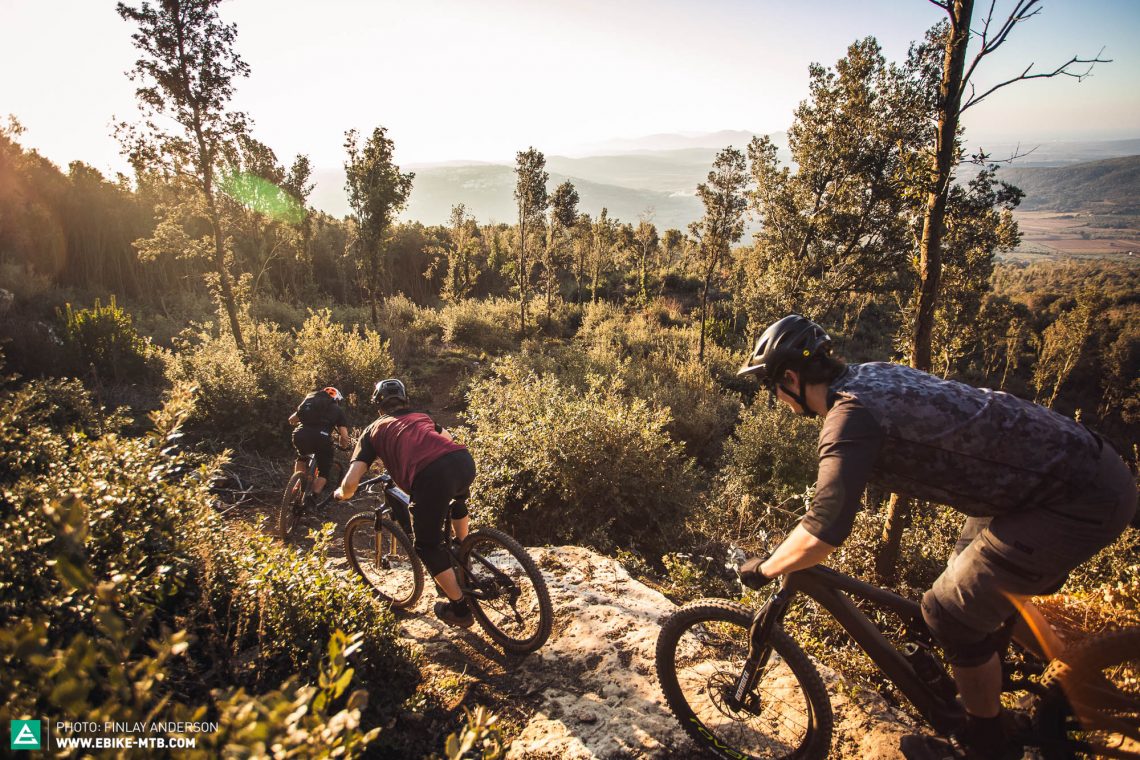
Motor and battery – an optimal balance of integration, performance and range
Since the launch of Bosch’s new motor in 2019, manufacturers have gone ballistic and released one new bike after another fitted with the new Performance CX drive. Seven out of eight bikes in this test use it. Only the Specialized Kenevo Comp relies on Specialized’s own 2.1 motor, which is based on the Brose Drive S Mag. However, Shimano also gifted us with some exciting updates last year, amongst them a new battery. If Commencal, YT Industries and Propain had sent their bikes in time for this test, there would be three bikes with a Shimano motor on the starting line.
While the new Bosch drive is heavily represented in this test, manufacturers don’t seem to follow a defined pattern when it comes to the integration of the whole Bosch system. Four out of the seven Bosch bikes rely on a Kiox display, but none of them use a standard Bosch bracket. That’s because it positions the display right on top of the stem, exposing it to potential hits and impacts when crashing. Instead, RADON, CUBE, Moustache and CENTURION place the colour display to the side of the steam where it’s more protected. There are still two options in terms of the speed sensor. As with most bikes now, it can be integrated in the dropout where it’s safely tucked away from nasty hits or, like the RADON and CUBE, attached to the chainstay, where it’s way more exposed to impacts and the elements. In this position, the sensor can easily get damaged by rocks and branches and the spoke magnet can get twisted or even lost. All bikes with a Bosch motor have one thing in common: a weird clunking noise from the inside of the motor when riding downhill. Whenever the rear-end compresses, the force transmitted through the chain results in a metallic clunk emanating from the motor. The sound reminds us of a chain hitting the chainstay.
Except for the Kenevo, which is fitted with a 500 Wh battery, all motors in this test draw their power from a Bosch Powertube 625. Nonetheless, this doesn’t mean that all bikes have the same range, because it’s impossible to derive the range of a bike solely based on its battery capacity. As a loyal E-MOUNTAINBIKE reader you might know that the range of an electric bike depends on countless other factors such as the efficiency of the suspension, tire pressure, speed, cadence, weight, temperature and more, with both the weight and riding style of the rider the main influencing factors.
If you want to be on the safe side in terms of range, you should take a closer look at the Haibike XDURO AllMtn 3.0 and SCOTT Genius eRide 920. Both are compatible with the Bosch DualBattery system, which relies on an optional additional 500 Wh battery placed in the frame triangle. Resulting in a total capacity of 1125 Wh, even long backcountry tours and Alpine crossing will be possible with this system. However, the additional weight and higher center of gravity affect the handling on the trail noticeably.

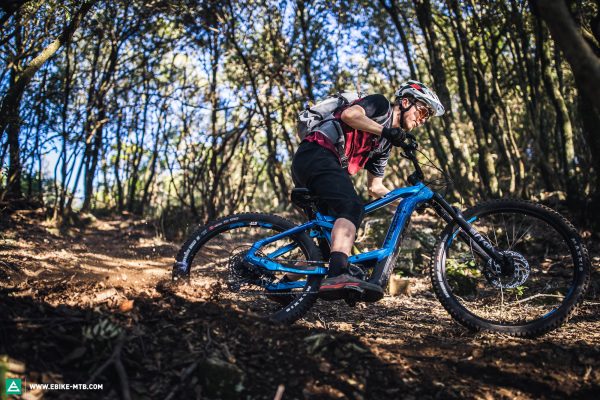
Who tested the bikes? Where were they tested?
Modern eMTBs are better and more versatile than ever and the best models are just as much fun on the trail as they are on long tours and on your everyday commute. In order to cover all possible scenarios during this test, our experienced team of eight riders tested the bikes on the challenging trails around Massa Vecchia in Italy, on their everyday commute in Germany and during fast-paced weekend blasts on the trails around our HQ in Stuttgart.

The trail paradise around Massa Vecchia is so beautiful that world champion Nino Schurter regularly hangs out there to ride, eat and relax. Of course, here at E-MOUNTAINBIKE we love it too! For this group test, we combined some of the best trail sections of Monte Arsenti to create a challenging 10 km test loop. This allowed us to compare the bikes’ performances and determined the biggest differences between them. Except for some climbs on really steep and blocked terrain, we tested uphill performance mainly on flowy and fun trails. The transfers between trails on wide gravel paths gave us an idea on how comfortable the bikes would be on extended tours. The downhill performance was tested on a wild combination of the most exciting trails around Massa Vecchia: the legendary El Nino, Freeride and Rock ‘n’ Roll Queen trails were (at least partially) included in our test loop. Berms, switchbacks, flowy waves, nasty rockgardens and challenging root carpets made up one hell of a test lap and guaranteed plenty of high fives and screams of joy – and the odd puncture too!

“Having fun is my priority! I have an active riding style and I like to ride fast while playing with the features the trails throw at me. My ideal eMTB needs to be agile, yet still offer balanced handling.”
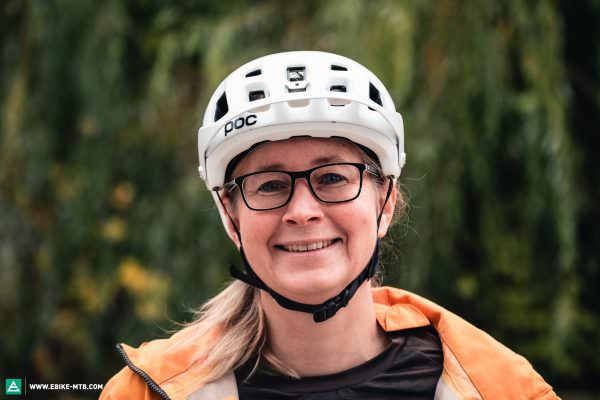
“As a newcomer, I value a simple setup. I need a light, good-natured and predictable bike, which inspires confidence both on long tours and my commute to work.

“Long days in the saddle are my thing – even better if they’re accompanied by spectacular Alpine landscapes. I often need an extra battery to reach remote peaks, which is why I’m willing to compromise on the handling. With their dual battery system, the Haibike and SCOTT are best suited to my needs.”

“I want to be able to use my eMTB to commute, hit the trails and sometimes even just to stroll down a cycle path. An integrated lighting system, comfortable riding position and a smooth transition at the 25 km/h assistance threshold are just as important as a lively handling on the trail!”

“I love exciting innovations and well-thought-out solutions, where the motor is cleverly and beautifully integrated into the eMTB. But it’s not just about the look: the Rail also offers the best handling in the entire test field.“

“I especially like riding eMTBs on alpine terrain where the trails are steep, rough and full of rocks. That’s why I need a robust set of wheels and tires as well as powerful brakes! My focus is on trail performance – the more natural the handling and power delivery, the better.”

“I love bike parks and trail centres! I like riding fast and playing with the terrain on my eMTB – oh, and I spend more time in the air than on the trail! A predictable, fast and composed bike is a must. The Trek sits right at the top of my list.”
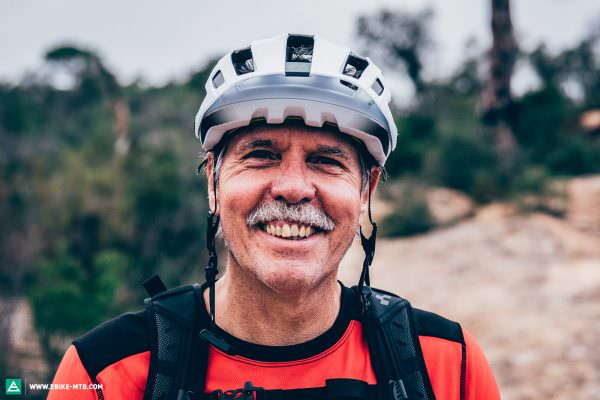
“I use eMTBs to commute and to tow my dog trailer – my labradoodle Henry doesn’t like to stay at home when I head into the E-MOUNTAINBIKE office. Unfortunately, few bikes are approved for trailers, which isn’t only annoying for me, but also for families with small children. When I ride with my buddies, without a trailer, I like a good-natured and comfortable bike.”

„After the Moustache Samedi 27 Trail 10 blew my mind with its phenomenal rear end in our last group test, I was very excited to try its big brother. And yes, even on the Samedi 29 Game 4, the shock and swingarm form a perfect unit: how can a rear end generate this much traction yet still support you this well? Unfortunately the overall package of the bike didn’t convince me.“

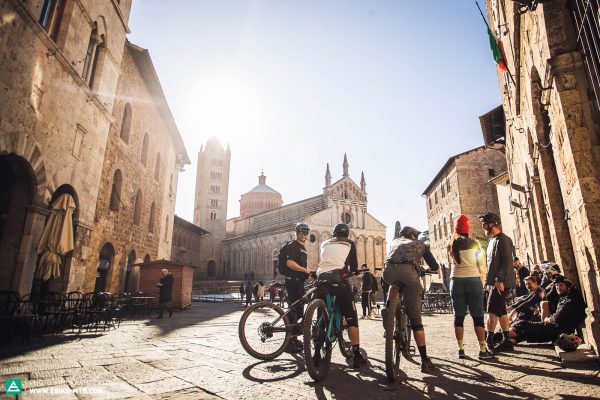

Even small details make big a difference
Let’s be honest, € 5,500 for an eMTB is still a lot of dough. And if you decide to bite the bullet and spend this sort of money, you’d expect to roll out of the shop and straight onto a trail with your new eMTB. But none of the bikes in our test is 100% trail-proof straight out of the box, all of them need some tuning before they can handle a full-on trail session – and by tuning we don’t mean unlocking the 25 km/h limit!
Silence, finally!
As soon as the trail points downhill and the sound of the motor is only audible on short uphill sprints, it becomes clear how much work and attention to detail each manufacturer has put into their bike. When you ride a perfect bike, the only noise you want to hear is the rubber of your tires carving through the trail. While all bikes feature a soft, noise-dampening plastic chainstay protector, only the Kenevo and Moustache come with a seat stay protector. Our tuning tip: buy a big roll of soft adhesive tape (e.g. slapper tape) and stick it on your chain- and seat-stays. Gear cables and brake lines can also potentially generate loud clattering noises, both around the cockpit and inside the frame. Here, all other manufacturers should take an example from SCOTT, who have by far the most cables in the cockpit area, but cleverly bundle them with the help of a special cable housing and thus provide a quiet ride.
Sensitivity
The contact points of a bike are crucial for good ergonomics and are important for a good first impression. Small details such as high-quality grips make a huge difference. At first glance, the SDG grips of the CUBE perfectly match the color scheme of the bike. However, the grips are extremely hard and transmit lots of vibration meaning that none of our test riders was impressed with them. Other components can also tell us where manufacturers tried to save money. The SDG Tellis dropper of the RADON and the X-Fusion Manic with Specialized’s in-house remote impressed the test crew with their fast operation, perfect ergonomics and low friction. With other bikes, it quickly became clear that this was where manufacturers had tried to save some pennies. The same goes for the groupset. SRAM’s entry-level SX Eagle groupset, which comes on five of our test bikes, can’t keep up with the shifting performance of the more expensive groupsets in test. To our surprise, the Specialized Kenevo still relies on an 11 speed drivetrain, which has a rather small gear range.
Only the tires touch the ground
Tires are one more easy way for manufacturers to save money without customers noticing. That’s because the biggest difference isn’t in the profile of the tire, but in the rubber compound and carcass, both of which aren’t as immediately obvious. While these make a massive difference in terms of performance, many riders aren’t aware of it. Head over to our big tire group test to find out everything you need to know. That fact is that the better tires have better puncture resistance, more grip and steering precision and thus offer a higher degree of safety (read braking distance). CUBE and Specialized are the only manufacturers in test who deliver their bikes with good quality, puncture-resistant tires which also provide good traction.
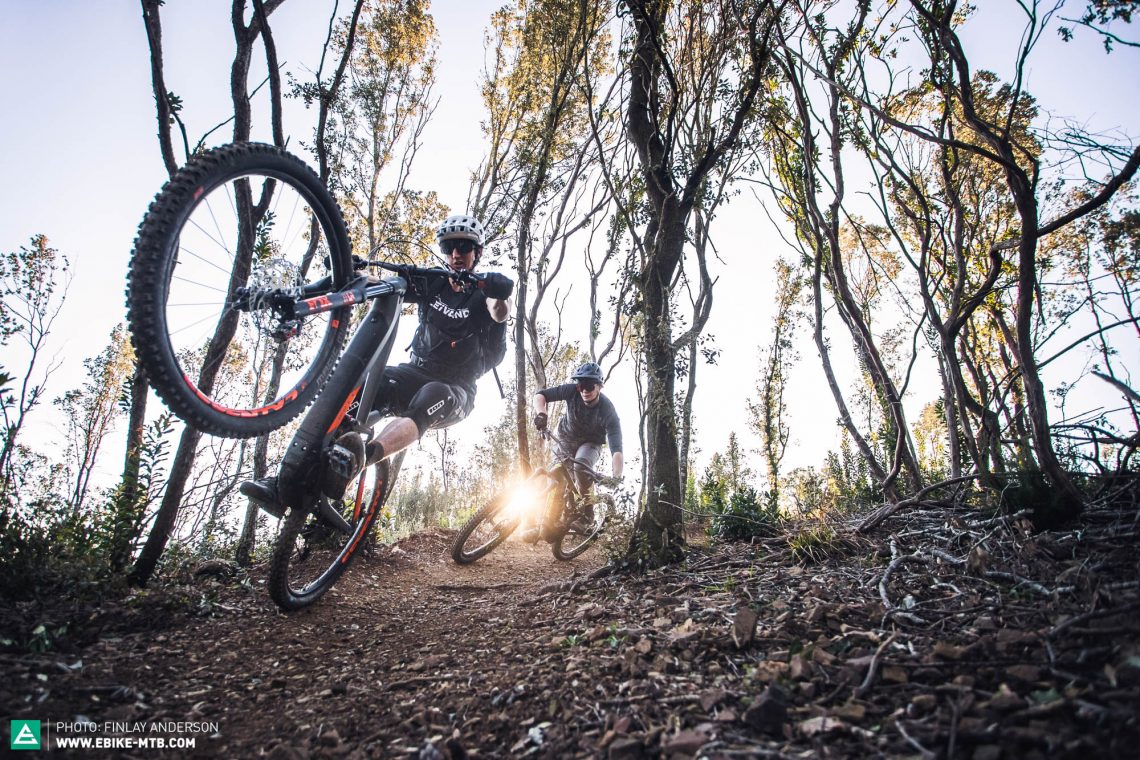
Which is the best eMTB under € 5,500?
At € 4,999, the CUBE Stereo Hybrid 140 HPC is one of the three cheapest bikes on test. In addition to the stylish look and solid overall impression, the carbon frame of the CUBE incorporates many smart details such as the integrated 625 Wh battery that hides inside the down tube. As far as price-performance ratio goes, the CUBE offers the best overall package in the entire test field: the well thought-out, trail-oriented spec perfectly complements the balanced geometry of the frame. Not least because of the high quality spec, which encompasses a top-end suspension platform, powerful brakes and great tires, the Stereo Hybrid 140 HPC suits a wide range of applications. No other bike in this test rides as intuitively and effortlessly on the trail while feeling as secure or safe. This makes it a true godsend especially for beginners. Thanks to the coherent overall concept and great performance, the Stereo Hybrid 140 HPC secures our coveted Best Buy badge!

The sophisticated and high quality alloy frame of the elegant Trek Rail 7 seamlessly integrates the Bosch motor it’s built around. As soon as you turn its nose downhill, the Trek Rail 7, which retails at € 5,499, dominates the test field. The Trek lives up to its name and on both flowy and very technical downhill trails it literally carves its way through the trail as though it’s on rails, steaming past the competition and delivering a snappy yet comfortable ride. No other bike offers the same level of predictable, confidence-inspiring and yet direct handling. The Rail 7 is the only bike that feels incredibly composed and agile at the same time. This bike is the perfect tool for sporty riders to explore and push their limits, but will also be a loyal companion for tour riders who are after a comfortable ride. The Trek Rail 7 hits the mark with sensational versatility, excellent handling and a high-quality frame, winning the deserved Best in Test!
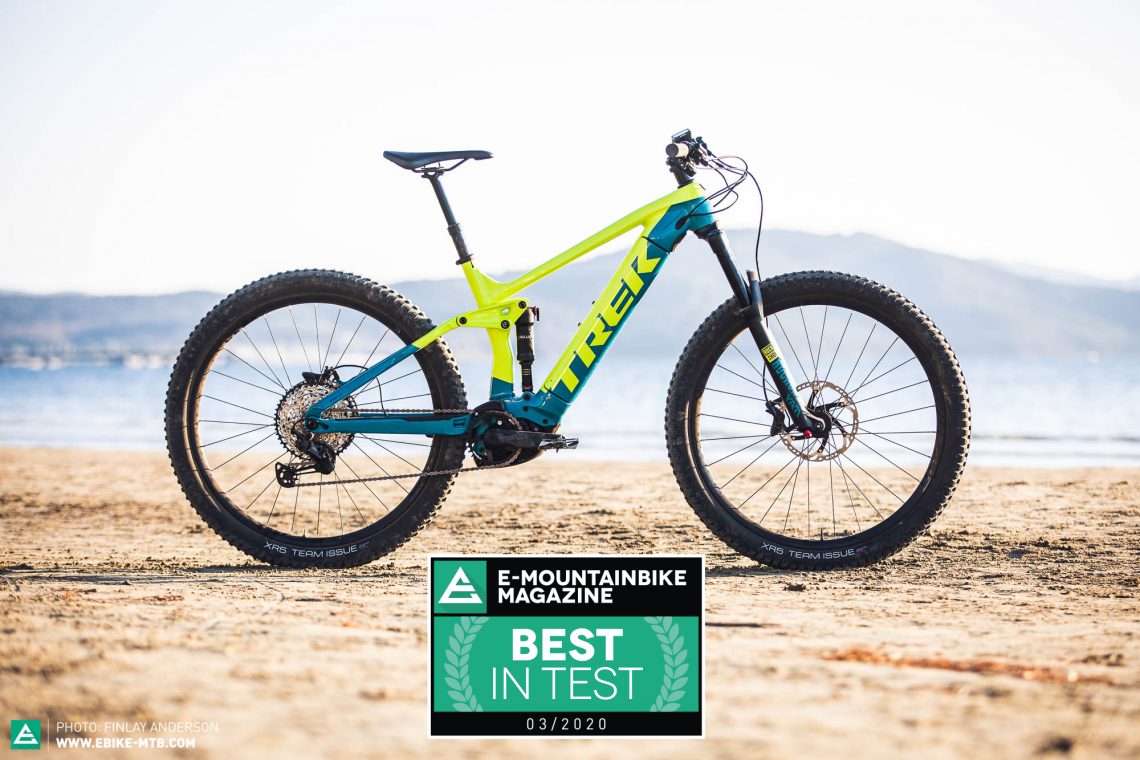
23.4 kg (size L) | € 5,499
All bikes in test: CENTURION No Pogo E R2600i (Click for review) | CUBE Stereo Hybrid 140 HPC (Click for review) | Haibike XDURO AllMtn 3.0 (Click for review) | Moustache Samedi 29 Game 4 (Click for review) | RADON RENDER 10.0 (Click for review) | Scott Genius eRIDE 920 (Click for review) | Specialized Kenevo Comp (Click for review) | Trek Rail 7 EU (Click for review)
Did you enjoy this article? If so, we would be stoked if you decide to support us with a monthly contribution. By becoming a supporter of E-MOUNTAINBIKE, you will help secure a sustainable future for high-quality cycling journalism. Click here to learn more.
Words: Photos: Finlay Anderson









